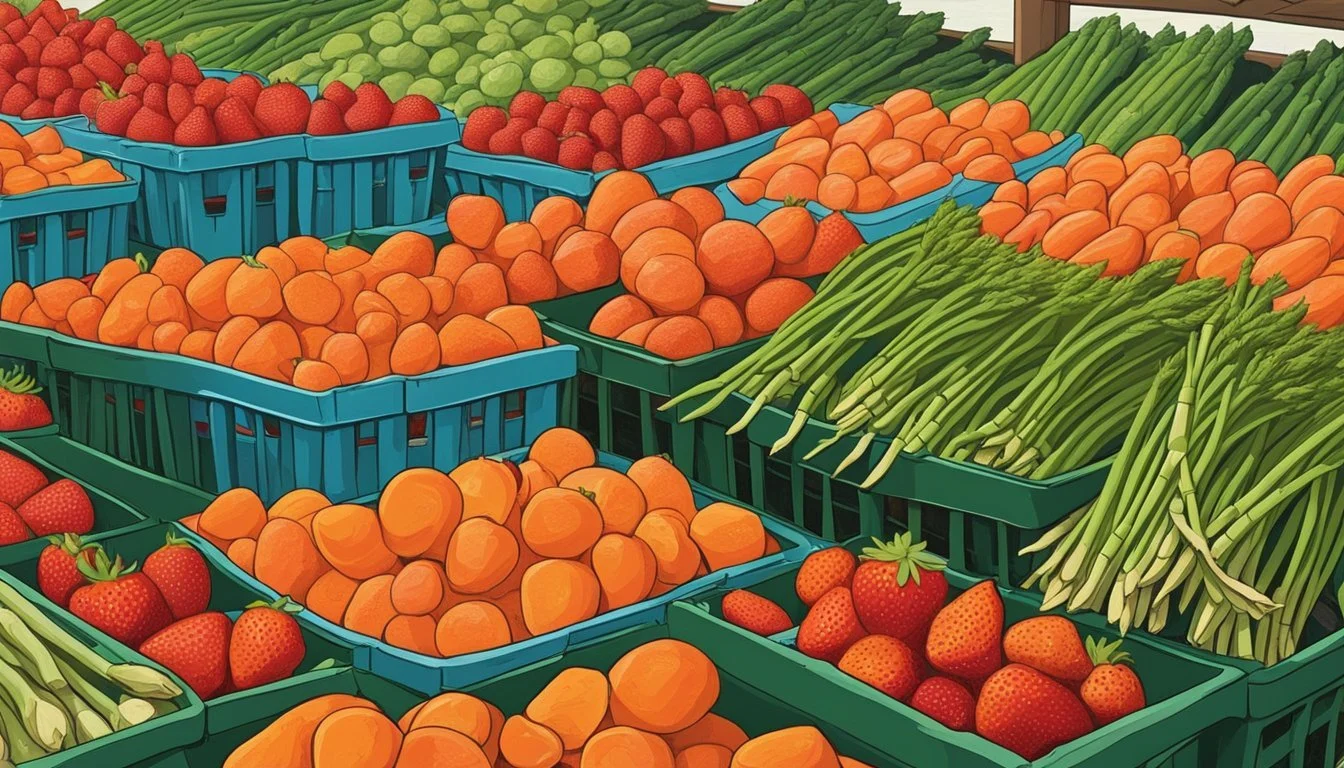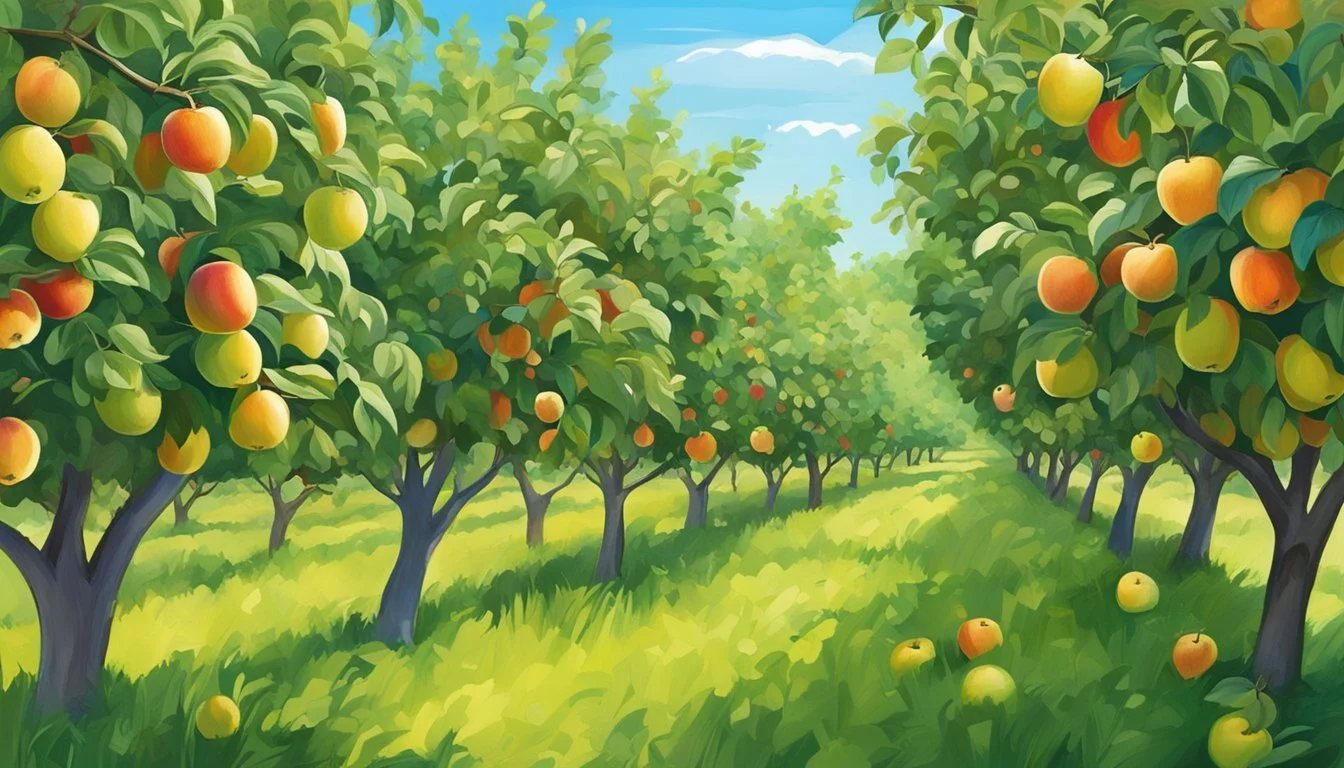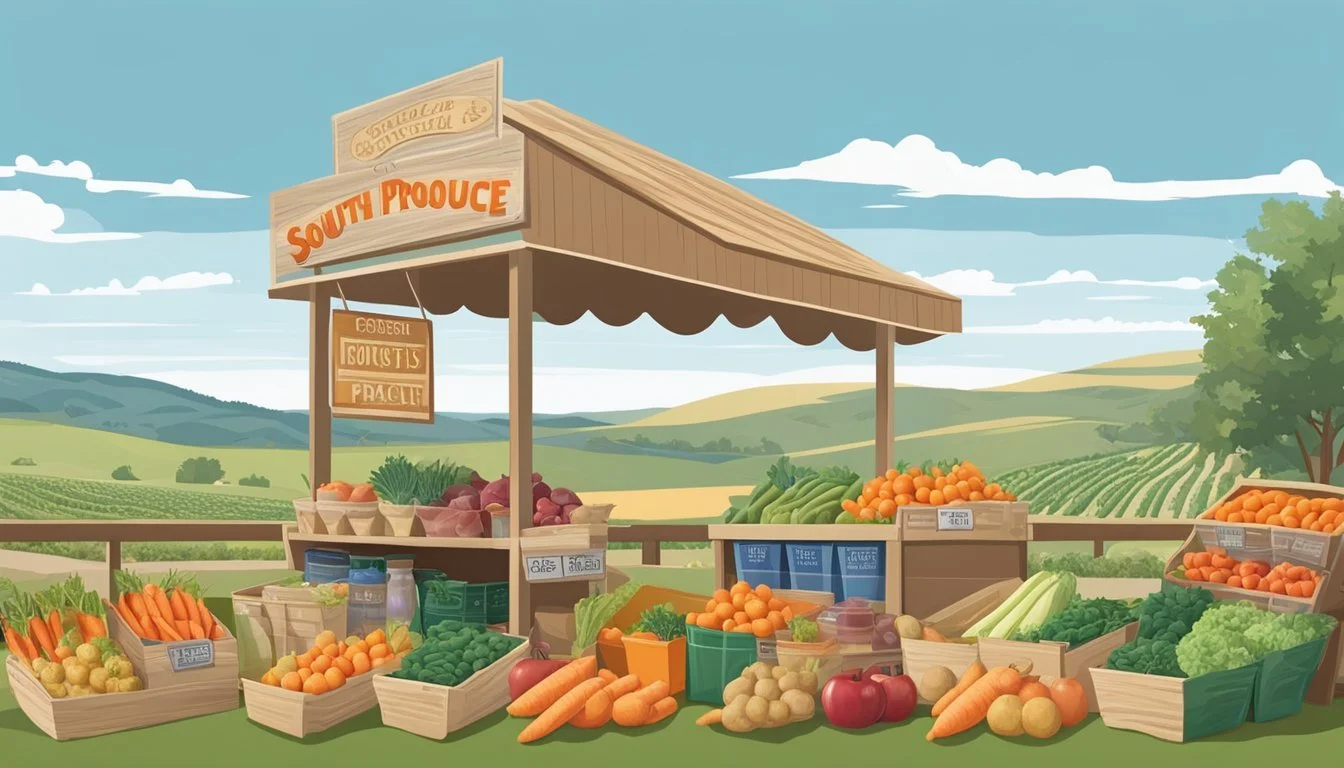South Dakota Seasonal Fruit & Vegetables in March
Your Guide to Fresh Produce
This Article is Part of our South Dakota Seasonal Fruit & Veg Calendar
March in South Dakota is a time of transition where the harsh winter begins to give way to the burgeoning spring. Despite the lingering cold, certain crops thrive in this climate, offering fresh produce to those eager to incorporate seasonal vegetables and fruits into their diet. The state's agriculture is adapted to the region’s unique conditions, ensuring that even during the cooler early spring, residents and local markets have access to a range of fresh produce.
Cold-hardy vegetables are the stars of the season in South Dakota during this month. Vegetables such as kale (What wine goes well with kale?) and spinach (What wine goes well with spinach?) not only survive but flourish in the chilly temperatures, providing a burst of green and a wealth of nutrients. Root vegetables, having been stored from previous harvests, also make a strong showing, ensuring that despite the season’s modesty in variety, the quality and freshness of produce remain high.
In South Dakota, March is not a peak time for fruit harvest, but storage practices and greenhouse cultivation may still provide a limited selection of fruits. The focus, however, remains on the robust vegetables that are in season. The climate presents an opportunity for farmers and consumers alike to embrace the hardy produce that can weather the state's colder days before the full onset of spring.
Seasonal Characteristics
Seasonal shifts heavily influence the availability and quality of produce. In South Dakota, March marks a transitionary period in agriculture due to unique climatic conditions that affect what fruits and vegetables are best to consume.
Climate Influence on Produce
The climate in South Dakota during March is characterized by the tail end of winter with hints of spring's arrival. This impacts produce availability, as cold-hardy vegetables can withstand the chill while others must be sourced from storage. Crucial to this period is the ability of certain crops to thrive in the cooler temperatures before the full onset of spring.
Cold-hardy Vegetables: Kale, Spinach
Stored Crops: Potatoes
March Seasonality in South Dakota
In March, South Dakota is not yet in the full swing of its growing season. Produce selection tends more towards stored crops from previous harvests and those few resilient vegetables that can endure the winter conditions.
Vegetables: Kale, Spinach
Stored: Potatoes
These crops typically offer robust flavor and nutrition, having been cultivated to survive or be preserved through the colder months leading up to spring.
Seasonal Fruits
March in South Dakota marks the transition period where last season's stored fruits are still available, and early spring fruits begin to emerge. During this time, consumers can expect to find a range of fruits that are ripe for consumption.
Common Fruits in March
Apples: While not freshly harvested, stored apples are still available and maintain their flavor.
Pears: Similar to apples, pears that have been stored properly can still be enjoyed for their sweetness.
It should be noted that due to South Dakota's climate, the variety of fresh fruits in March is limited. As the growing season progresses, more variety will become available.
Benefits of Seasonal Fruit Consumption
Consuming fruits that are in season in March presents several benefits:
Flavor: Seasonal fruits are picked at the peak of their freshness, ensuring that they have the best possible flavor.
Nutrition: Fruits consumed within their natural harvest season often contain more nutrients.
They encourage the selection of the freshest options available, which can contribute positively to one's diet.
Seasonal Vegetables
In March, South Dakotans harvest a variety of cold-hardy vegetables, each offering robust flavors and essential nutrients despite the chilly temperatures.
Vegetable Harvesting in March
During March, the South Dakota landscape yields a bounty of hearty vegetables well-adapted to the cooler climate:
Kale and Spinach: These leafy greens are at their peak, delivering both texture and nutrition. Harvest continues for these resilient greens.
Broccoli and Cabbage: With a robust constitution, these cruciferous vegetables are ready for picking, providing a versatile base for many dishes.
Peas: A significant source of plant-based protein, peas begin to become available this month.
Lettuce: Various types of lettuce emerge, ideal for fresh salads.
Radishes: These fast-growing root vegetables add a spicy kick to the seasonal produce selection.
It's important to note that the availability of certain crops like asparagus (What wine goes well with asparagus?), beans, and peppers may vary, as these typically start later in the spring.
Health and Nutrition
The vegetables harvested in March not only survive the cold but are nutritionally potent:
Kale and Spinach: Rich in vitamins A, C, and K, as well as iron and antioxidants.
Broccoli and Cabbage: Known for their fiber content and cancer-fighting compounds like sulforaphane.
Peas: Offer vitamins and minerals, including B vitamins and vitamin K.
Lettuce: Generally low in calories, a good source of folate and vitamin K.
Radishes: Contain small amounts of vitamin C and potassium.
These vegetables contribute to a balanced diet and support overall health, making them valuable additions to meals during South Dakota's March harvest.
Farming Practices
In South Dakota, the farming practices in March focus on the use of sustainable methods and capitalizing on local farming advantages to deliver fresh and raw produce to markets.
Sustainable Agriculture
Farmers in South Dakota have adopted sustainable agriculture practices to maintain and improve environmental quality while producing nutritious foods. Crop rotation, cover cropping, and the application of organic soil amendments are commonly used to enhance soil health and reduce reliance on chemical fertilizers and pesticides. By focusing on sustainable techniques, farmers ensure the long-term viability of their land for future cultivation of produce.
Local Farming Advantages
Local farmers in South Dakota offer significant advantages by supplying fresh, raw produce directly to consumers through farmers' markets and local food systems. These closer-to-home operations allow farmers to:
Minimize transportation: Shorter distances help reduce carbon emissions and ensure the freshness of produce.
Support the local economy: Consumers purchasing from local farmers directly bolster the community's economic well-being.
Build community relationships: Direct interactions at local markets create a strong bond between farmers and consumers, fostering trust and knowledge about the food's origin.
By focusing on local markets, South Dakota farmers provide fresh and sustainable produce tailored to the preferences and needs of their immediate communities.
Preparation and Recipes
March in South Dakota brings a variety of fresh produce that can enliven one’s cooking repertoire. Utilizing these ingredients in recipes ensures dishes are packed with flavor and nutrients.
Cooking with March Produce
Incorporating fresh March produce into cooking can elevate the taste and nutritional content of everyday meals. Steaming, roasting, and incorporating vegetables into salads are all effective methods. Salad greens, for example, can be used fresh and require minimal preparation to preserve their crisp texture and nutrients. Asparagus or artichokes (What wine goes well with artichokes?), which come into season, yield better flavor and texture when roasted with a bit of olive oil and seasoning.
Vegetable Preparation:
Asparagus: Trim the ends, and roast, grill, or steam.
Artichokes: Remove the tough outer leaves, slice off the top, and stem, then boil or steam.
Let's take a look at how one can turn these items into delightful dishes.
Recipe Ideas
One can showcase South Dakota's March produce through a variety of recipes. Fresh salad greens can be the base of a vibrant salad, tossed with a simple vinaigrette to let the flavors shine through. Roasted asparagus makes a perfect side dish, or it can be chopped and added to stir-fries. Meanwhile, artichokes, with their subtle, nutty flavor, can be transformed into a delectable dip or a filling for a healthy, flavorful salad.
Suggested Dishes:
Salads: Mixed greens with vinaigrette, artichoke heart salad
Sides: Roasted asparagus with garlic, sautéed salad greens
Main Courses: Asparagus risotto, artichoke pasta (how long does pasta last?) dishes
By focusing on the intrinsic flavors of each vegetable, one can create dishes that are both fresh and satisfying.
Shopping Guide
When shopping in South Dakota during March, consumers can benefit from knowing what produce is fresh and in season. This guide will outline where to find fresh produce and provide tips for seasonal buying.
Finding Fresh Produce
Shoppers looking for fresh fruits and vegetables should consider visiting local farmers' markets and grocery stores that prioritize local suppliers. Not only does this support the local economy, but it also offers an opportunity to purchase the freshest options available. Many varieties of produce reach their peak during specific months, and for March in South Dakota, one can expect to find an array of items incorporating both the end of winter staples and the beginning of spring offerings.
Seasonal Buying Tips
Produce Buying Tips for March:
Look for Winter Produce: Items like potatoes, carrots, and onions are still available and are excellent for hearty stews and roasts.
Welcome Spring Varieties: As spring approaches, watch for the arrival of greens such as spinach and kale, which are among the first to appear in the new season.
Check the Signs of Freshness: Firmness in root vegetables, vibrant colors in greens, and intact skins are good indicators of fresh produce.
Ask Vendors: If unsure about the seasonality of items, speaking to local farmers and vendors can provide insights into what is best to buy at the time.
Plan Meals Around Seasonal Produce: This not only offers the best taste and nutritional value but can also be more cost-effective.
Storage and Preservation
For those interested in maintaining the freshness of South Dakota's seasonal produce during March, it's essential to understand proper storage and preservation methods. This ensures the longevity and taste of the fruits and vegetables.
Freshness is key when storing produce. Most vegetables should be kept in a refrigerator, ideally in the crisper drawer to maintain an optimal level of moisture. Specific storage temperatures vary, but they typically range between 32 and 36 degrees Fahrenheit with a humidity level of 90% to 95%. This environment helps in preserving their freshness for a longer period.
Preservation methods such as canning, freezing, and drying offer alternative ways to extend the longevity of produce. For instance, root vegetables like potatoes, which are in season, store well in a cool, dark, and dry space and can last for months. Here is a summary of storage guidelines for select produce available in March:
Produce Storage Method Preservation Method Potatoes Cool, dark, dry place Canning, Freezing Cabbage Refrigerator Fermentation, Freezing Raspberries Refrigerate or Freeze Freezing, Jamming
Freezing is particularly effective for berries, such as raspberries. They should be laid out in a single layer on a baking sheet to freeze before transferring to an airtight container, preventing the fruits from sticking together and making them easier to use later.
Drying fruits and vegetables is another viable preservation technique, especially for items with lower water content. This method drastically reduces their weight and size, which is convenient for storage and extends their shelf-life remarkably.
Gardening Tips
March brings the onset of spring gardening in South Dakota. It's important for gardeners to understand the best planting practices and timings to ensure a successful harvest.
Growing Your Own Vegetables
One begins their gardening endeavor by selecting suitable vegetables for the local climate. South Dakota falls within hardiness zones 3 to 5, which determines the types of vegetables that will thrive. Given the fluctuating spring temperatures, gardeners should focus on cold-hardy vegetables. These may include lettuce, radishes, peas, and carrots.
Planting Calendar for South Dakota
A strategic approach to planting entails adherence to a calendar to maximize the growing season. Tomatoes, for instance, should be started indoors before being transplanted after the last frost. The table below provides a concise planting guide:
Vegetable Indoor Start Transplant or Direct Sow Tomatoes 6-8 weeks before last frost After last frost when soil is warm Lettuce — Direct sow as soon as the soil can be worked Peas — Direct sow in March or as soon as soil can be worked Radishes — Direct sow in March
Consistent monitoring and maintenance of the garden will lead to timely and successful harvests. Gardeners should prepare for the growing season by familiarizing themselves with the plants' specific needs and the local growing conditions.
Nutritional Information
March in South Dakota sees a limited range of fresh produce due to the cold climate. However, the vegetables that are robust enough to survive, such as kale and spinach, offer significant health benefits.
Kale is a nutritional powerhouse, dense in vitamins A, C, and K. It is also rich in minerals like calcium and potassium, offering support for bone health and cardiovascular wellness. The antioxidants found in kale, such as quercetin and kaempferol, have been studied for their potential in reducing stress and combating inflammation.
Spinach, a leafy green, is similarly nutrient-rich. It provides iron, which is essential for blood health, especially for those at risk of anemia. Spinach is also a great source of folate, magnesium, and vitamins B6, B9, and E. The inclusion of spinach in one's diet aids in maintaining healthy skin and hair, and supports the immune system.
Both vegetables are low in calories and high in dietary fiber, which can aid in digestion and promote satiety, potentially assisting in weight management efforts. They also contain plant compounds that can contribute to overall health, offering various antioxidants that protect the body from oxidative stress.
Consuming these vegetables, whether fresh, frozen, canned, or even in juice form, contributes to the daily recommended intake of fruits and vegetables. Including a variety of these produce options ensures a balanced intake of essential nutrients, supporting overall well-being.
Community and Events
In March, South Dakota's agricultural community thrives through various local events and farmers' markets, which provide opportunities for residents and visitors to engage with regional growers and celebrate the onset of spring.
Local Farmers' Markets
Farmers' markets in South Dakota serve as focal points for community interaction and support for local agriculture. The city markets in March are known for offering products like kale, spinach, and other cold-hardy vegetables that can endure the region's cool temperatures.
Brookings Farmers' Market: Engages the community by providing a selection of fresh, locally-grown produce, even in the cooler early spring.
Sioux Falls Farmers' Market: Farmers here are known for their sustainable practices, showcasing the ingenuity and resilience of South Dakota's agricultural community.
Seasonal Festivals
Seasonal festivals celebrate local produce and traditions, and in March, these events mark the transition from winter to spring.
South Dakota Crunch Off: This statewide event encourages participants to enjoy local fruits and vegetables, highlighting the state's commitment to farm-to-school initiatives.
Annual Agriculture Conference: Features workshops on specialty crops, offering attendees insight into the local agricultural landscape and upcoming growing seasons.











